What is brazing?
Brazing is the joining of metals through the use of heat and a filler metal – one whose melting temperature is above 840°F (450°C) but below the melting point of the metals being joined. (A more exact name for the brazing process discussed in this book may be “silver brazing,” since in most cases the filler metal used is a silver alloy. To remain brief, we’ll use the term “brazing” throughout this book, with the understanding that we are referring to a torch brazing process with a silver-bearing filler metal. Where exceptions occur, it will be noted.) Brazing is probably the most versatile method of metal joining today, for a number of reasons. Brazed joints are strong. On non- ferrous metals and steels, the tensile strength of a properly made joint will often exceed that of the metals joined. On stainless steels, it is possible to develop a joint whose tensile strength is 130,000 pounds per square inch. ( 896.3 megapascal [MPa] ). Brazed joints are ductile, able to withstand considerable shock and vibration. Brazed joints are usually easy and rapidly made, with operator skill readily acquired. Brazing is ideally suited to the joining of dissimilar metals. You can easily join assemblies that combine ferrous with nonferrous metals, and metals with widely varying melting points. Brazing is essentially a one-operation process. There is seldom any need for grinding, filing or mechanical finishing after the joint is completed. Brazing is performed at relatively low temperatures, reducing the possibility of warping, overheating or melting the metals being joined. Brazing is economical. The cost- per-joint compares quite favorably with joints made by other metal joining methods. Brazing is highly adaptable to automated methods. The flexibility of the brazing process enables you to match your production techniques very closely to your production requirements. With all its advantages, brazing is still only one of the ways in which you can join metals. To use brazing properly, you must understand its relationship to other metal jointing methods. What are some of those methods and which should you use where?
The versatility of brazing.
- Strong joints
- Ductile joints
- Ease of operation
- Suited to dissimilar metals
- One-operation process
- Requires low temperatures
- Economical
- Highly adaptable to automation
The many ways to join metals.
Brazing, as we’ve noted, relies on heat and a filler metal to join metals. There is nothing unique about this. Welding and soldering are similar in these respects. And metals can also be joined efficiently and economically without the need for heat or a filler metal at all, by mechanical fastening or adhesive bonding. When would you use brazing, rather than one of these other methods? It depends on the circumstances. Let’s start our evaluation of brazing as a metal joining method by eliminating those situations were brazing is generally unsuitable. The first of these situations is the non-permanent joint. This is the joint that’s made with future disassembly in mind. (For example, a pump connected to a piping assembly.)
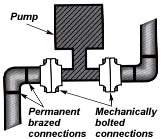
The pipes won’t wear out, but some day the pump will. It’s easier to disassemble a threaded or bolted pump connection than a brazed con- nekton. (You can “de-braze” a brazed joint if you have to, but why plan on it?) For the typical non-permanent joint, mechanical fastening is usually the most practical method. There’s another kind of joint where brazing will likely be your last, rather than your first, consideration. And that is the permanent, but low-strength joint. If you’re joining metal assemblies that won’t be subjected to much stress or strain, there are frequently more economical ways to join them than by brazing. (Mechanical fastening, for example, or soft soldering or adhesive bonding.) If you are selecting a method to seal the seams of tin cans, there is nothing to stop you from brazing. Yet soft-soldering would be perfectly adequate for this low-stress type of bond. And soft-soldering is generally less expensive than brazing. In these two areas – the non- permanent joint and the permanent but low-strength joint – other joining methods are adequate for the job and usually more economical than bronzing.
Where does brazing fit in?
Consider brazing hen you want permanent and strong metal-to-metal joints. Mechanically-fastened joints (threaded, staked, riveted, etc.) generally don’t compare to brazed joints in strength, resistance to shock and vibration, or leak-tightness. Adhesive bonding and soldering will give you permanent bonds, but generally neither can offer the strength of a brazed joint – strength equal to or greater than that of the base metals themselves. Nor can they, as a rule, produce joints that offer resistance to temperatures above 200°F (93°C). If you want metal joints that are both permanent and strong, it’s best to narrow down your consideration to welding and brazing. Welding and brazing both use heat. They both use filler metals. They can both be performed on a production basis. But the resemblance ends there. They work differently, and you need to understand the nature of that difference to know which method to use where.
How welding works.
Welding joins metals by melting and fusing them together, usually with the addition of a welding filler metal. The joints produced are strong, usually as strong as the metals joined or even stronger. In order to fuse the metals, a concentrated heat is applied directly to the joint area. This heat is high temperature. It must be – in order to melt the “base” metals (the metals being joined) and the filler metals as well. So welding temperatures start at the melting point of the base metals. Because welding heat is intense, it is impractical to apply it uniformly over a broad area. Welding heat is typically localized, pinpointed heat. This has its advantages. For example, if you want to join two small strips of metal at a single point, an electrical resistance welding setup is very practical.
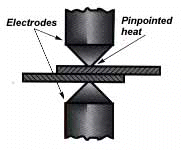
This is a fast, economical way to make strong, permanent joints by the hundreds and thousands. However, if the joint is linear, rather than pinpointed, problems arise. The localized heat of welding tends to become a disadvantage. For example, suppose you want to butt- weld two pieces of metal – start by beveling the edges of the metal pieces to allow room for the welding filler metal. Then weld, first heating one end of the joint area to melting temperature, then slowly traveling the heat along the joint line, depositing filler metal in synchronization with the heat. This is a typical conventional welding operation. Let’s look at its characteristics.
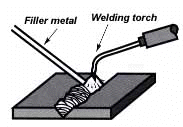
It offers one big plus – strength. Properly made, the welded joint is at least as strong as the metals joined. But there ore minuses to consider. The joints made at high temperatures, high enough to melt both base metals and filler metal. High temperatures can cause problems, such as possible distortion and warping of the base metals or stresses around the weld area. These dangers are minimal when the metals being joined are thick. But they may become problems when the base metals are thin sections. High temperatures are expensive as well since heat is energy, and energy costs money. The more heat you need to make the joint, the more the joint will cost to produce. Now consider the automated process. What happens when you join not one assembly, but hundreds or thousands of assemblies. Welding, by its nature, presents problems in automation. We know that a resistance weld joint made at a single point is relatively easy to automate. But once the point becomes a line – a linear joint – the line has to be traced. It’s possible to automate this tracing operation, moving the joint line, for example, past a heating station and feeding filler wire automatically from big spools. But this is a complex and exacting setup, warranted only when you have large production runs of identical parts. Of course, welding techniques continually improve. You can weld on a production basis by electron beam, capacitor discharge, friction and other methods. But these sophisticated processes usually call for specialized and expensive equipment and complex, time consuming setups. They’re seldom practical for shorter production runs, changes in assembly configuration or – in short – typical day-to- day metal joining requirements.
How brazing works.
A brazed joint is made in a completely different way from a welded joint. The first big difference is n temperature. Brazing doesn’t melt the base metals. So brazing temperatures are invariably lower than the melting points of the base metals. And, of course, always significantly lower than welding temperatures for the same base metals. If brazing doesn’t fuse the base metals, how does it join them. It joins them by creating a metallurgical bond between the filler metal and the surfaces of the two metals being joined.
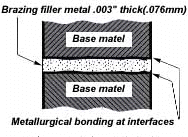
The principle by which the filler metal is drawn through the joint to create this bond is capillary action. In a brazing operation, you apply heat broadly to the base metals. The filler metal is then brought into contact with the heated parts. It is melted instantly by the heat in the base metals and drawn by capillary action completely through the joint.
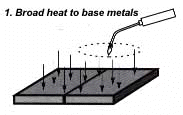

This, in essence, is how a brazed joint is made. What are the advantages of a joint made this way?
Advantages of a brazed joint.
First, a brazed joint is a strong joint. A properly-made brazed joint (like a welded joint) will in many cases be as strong or stronger than the metals being joined. Second, the joint is made at relatively low temperatures. Brazing temperatures generally range from about 1150°F to 1600°F (620°C to 870°’C). Most significant, the base metals are never melted. Since the base metals are not melted, the can typically retain most of their physical properties. And this “integrity” of the base metals is characteristic of all brazed joints, of thin-section as well as thick-section joints. Also, the lower heat minimizes any danger of metal distortion or warping. (Consider too, that lower temperatures need less heat which can be a significant cost-saving factor.) And important advantage of brazing is the ease with which it joins dissimilar metals. If you don’t have to melt the base metals to join them, it doesn’t matter if they have widely different melting points. You can braze steel to copper as easily as steel to steel. Welding is a different story. You must melt the vase metals to fuse them. So if you try to weld copper (melting point 1981°’F/1083°C) to steel (melting point 2500°F/1370°C), you have to employ rather sophisticated, and expensive, welding techniques. The total ease of joining dissimilar metals through conventional brazing procedures means you can select whatever metals are best suited to the function of the assembly–knowing you’ll have no problem joining them no matter how widely they vary in melting temperatures. Another advantage of a brazed joint is its good appearance. The comparison between the tiny, neat fillet of a brazed joint and the thick, irregular bead of a welded joint is like night and day.
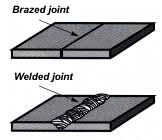
This characteristic is especially important for joints on consumer products, where appearance is critical. A brazed joint can almost always be used as is, without any finishing operations needed. And that too is a money-saver. Brazing offers another significant advantage over welding in that brazing skills can usually be acquired faster than welding skills. The reason lies in the inherent difference between the two processes. A linear welded joint has to be traced with precise synchronization of heat application and deposition of filler metal. A brazed joint, on the other hand, tends to “make itself” through capillary action. (A considerable portion of the skill involved in brazing actually lies in the design and engineering of the joint.) The comparative quickness with which a brazing operator may be trained to a high degree of skill is an important cost consideration. Finally, brazing is relatively easy to automate. The characteristics of the brazing process – broad heat applications and ease of positioning of filler metal – help eliminate the potential for problems. There are so many ways to get heat to the joint automatically, so many forms of brazing filler metal and so many ways to deposit them, that a brazing operation can easily be auto- mated to the extent needed for almost any level of production.
Brazing advantages
- Joint strength
- Lower temperatures/lower cost
- Maintains integrity of base metals
- Dissimilar metals easily joined
- Good joint appearance
- Operator skill easily acquired
- Process easily automated
Which Joining method is the best?
As we’ve indicated, when you want to make strong and permanent metal joints, your choice will generally narrow down to welding or brazing. So, which method is best? It depends entirely on the circumstances. The key factors in making a decision will boil down to the size of the parts to be joined, the thickness of the metal sections, configuration of the joint, nature of the base metals, and the number of joints to be made. Let’s consider each of them.
How big is the assembly?
Welding is usually more suited to the joining of large assemblies than brazing. Why? Because in brazing the heat must be applied to a broad area, often to the entire assembly. And if the assembly is a large one, it’s often hard to heat it to the flow point of the filler metal as the heat tends to dessipate faster than you build it up. You don’t meet this limitation in welding. The intense localized heat of welding, sometimes a drawback, becomes an advantage in joining, a large assembly. So does welding’s ability to trace a joint. There’s no way to establish exactly the point at which size of assembly makes one metal joining method more practical than another. There are too many factors involved. For example, if the assembly is unable to be brazed in open air (torch, induction, etc.) due to size, a furnace or dip brazing process may eliminate the size consideration. However, you can still use this rule-of-thumb as a starting point: Large assembly-weld, if the nature of the metals permits. Small assembly-braze. Medium-sized assembly-experiment.
How thick are the metal sections?
Thickness of base metal sections is an important consideration in selecting your metal joining method. If both sections are relatively thick – say .500″ (12.7mml – either welding or brazing can produce a strong joint. But if you want to make a T-joint, bonding a .005″ (.127mm) thick sheet metal section to half-inch stock for example, brazing is the better choice. The intense heat of welding is likely to burn through, or at least warp, the thin section. The broader heat and lower temperature of brazing allows you to join the sections without warpage or metal distortion.
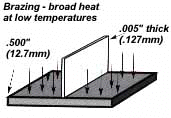
What’s the joint configuration?
Is the joint a “spot” or a “line” 2 A spot joint made at one point can be accomplished as easily by welding as by brazing. But a linear joint – all other things being equal – is more easily brazed than welded. Brazing needs no manual tracing. The filler metal is drawn through the joint area by capillary action, which works with equal ease on any joint configuration.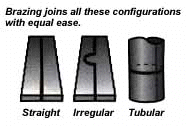
What metals are you joining?
Suppose you’re planning a two- section metal assembly. You want high electrical conductivity in one section, high strength and corrosion resistance in the other. You want to þ se copper for conductive, and stainless for strength and corrosion resistance. Welding this assembly »ill present problems. As we’ve seen, you have to melt both metals to fuse them. But stainless melts at a much higher temperature than copper. The copper would completely melt and flow off before the stainless came anywhere close to its melting temperature. Brazing these dissimilar metals offers no such obstacle. All you have to do is select a brazing filler metal that is metallurgically compatible with both base metals and has a melting point lower than that of the two. You get a strong joint, with minimal alteration of the properties of the metals. The point to remember is that brazing joins metals without melting them, by metallurgically bonding at their interfaces. The integrity and properties of each metal in the brazed assembly are retained with minimal change. If you plan to join dissimilar metals – think brazing.
How many assemblies do you need?
For a single assembly, or a few assemblies, your choice between welding and brazing will depend largely on the factors discussed earlier – size of parts, thickness of sections, joint configurations, and nature of base metals. Whether you braze or weld, you’ll probably do the job manually. But when your production needs run into the hundreds, or thousands (or hundreds of thousands), production techniques and cost factors become decisive. Which method is best – for production metal joining? Both methods can be automated. But they differ greatly in flexibility of automation. Welding tends to be an all-or-nothing proposition. You weld manually, one-at-a-time, or you install expensive, sophisticated equipment to handle very large runs of identical assemblies. There’s seldom a practical in-between. Brazing is just the opposite. You can braze “one-at-a-time” manually, of course. But you can easily introduce simple production techniques to speed up the joining of several hundred assemblies. As an example, many assemblies, pre-fluxed and bearing pre-placed lengths of filler metal, can be simultaneously heated and brazed in a furnace. When you get into larger runs, it may become practical to rig up a conveyor which can run the assemblies past banks of heating torches and brazing filler metal can be applied to the joint in a pre- measured amount. And there are endless “in-between” possibilities, a good many of which you can accomplish with relatively inexpensive production devices. The point to keep in mind is that brazing is flexible. You can automate it on a step-by-step basis, at each step matching your automation investment to your production requirements.
Welding vs. Brazing considerations
- Size of assembly?
- Thickness of base metal sections?
- Spot or line joint?
- Metals being joined?
- Final assembly quantity needed?
.


[…] What Brazing is All About […]